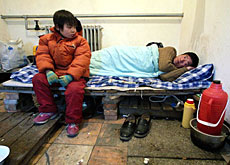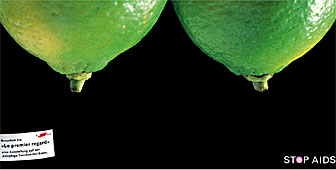Putting Aids in the picture

Aids prevention posters from around the world have been put on display at Zurich's museum of design.
As well as appealing to design students, organisers hope the exhibition can help revive public interest in the dangers of Aids and HIV.
“Primarily, the museum was interested in presenting these images as a way of considering how different countries and cultures address a pressing global theme,” curator Bettina Richter told swissinfo.
“But we also want to address the growing complacency in countries like Switzerland, where a lot of people seem to think they know all about Aids and HIV and don’t need to hear anymore.”
A rise in the number of HIV infections in Switzerland over the past two years, following eight years of steady decline, would seem to back up Richter’s concerns, and the contrasting images on show at the museum certainly offer plenty of interesting new angles on a well-examined subject.
Early days
The exhibition has a rough chronology which also serves as a reminder of the progress made since the early days of Aids awareness.
Some of the earliest posters display bleak pronouncements such as “Aids leads to death” along with simplistic religious morals and sketches of coffins and skeletons.
Many of the crudest and often misleading images come from the developing world, but Richter is quick to point out that the fight against Aids has not always been an area in which the West has excelled.
“The USA was particularly slow in getting to grips with Aids information,” Richter says, “and there are plenty of good examples in the exhibition of informative, well-designed posters which appeared very early on in countries such as India and Vietnam.”
“Here’s an example of a very good poster from Africa,” Richter adds, stopping by a sketch of a teacher explaining the dangers of Aids to inhabitants of a Kenyan village.
“The message makes clear that Aids is not a form of witchcraft, something which was commonly believed in the early days of the disease.
“The poster also explains how people can protect themselves. It advocates sex with one partner, but also adds that those who wish to sleep with multiple partners should definitely use a condom – that was a message which came relatively late elsewhere, including Switzerland.”
Many of the most striking differences among the 70-odd posters on display in Zurich are differences of style. Countries with high illiteracy rates, for example, depend a good deal on simple illustrations to explain the threat of Aids.
Common messages
The preference for drawn illustrations in the developing world contrasts with the emphasis on photography in the developed world. But, aside from the visual variety, there are many common messages to be seen – particularly in more recent poster campaigns.
By way of example, Richter pauses by a collection of posters from India, the Netherlands and Uganda, each of which shows a woman handing a condom to her male partner.
“The Ugandan and Indian posters both use traditional styles of drawing and it’s only with a second glance that we notice that the women are holding condoms,” Richter points out.
“The Dutch poster is much brighter and trendier – but all three show a global emphasis on self-protection which is far removed from those earlier images of death and stigmatism.”
That is not to say that different approaches do not still abound in the field of Aids prevention – even between neighbouring countries in western Europe.
Swiss coy?
The final wall of the Zurich exhibition contains two recent posters from Switzerland and two from Austria. While the Swiss resort to phallic vegetables to catch the eye, the Austrians opt for extreme close-ups of male and female genitalia, including one shot of an erect penis, complete with condom wrapping.
“The Austrian campaign is extremely direct and very effective,” Richter says, “and you see straight away what Aids prevention is all about. The Swiss approach on the other hand is a lot more implicit and I’m not sure how it really helps to break down taboo subjects.”
But couldn’t it be argued that the fruit imagery is simply an attempt to try out something new on a jaded public? After all, it wasn’t that long ago that the same advertising agency was confronting Swiss cinema audiences with a image of a knotted penis to convey the message “no condom, no sex”.
Subjective
“That’s true,” concedes Richter, “and of course these things are always a little subjective, but even with that Swiss cinema campaign I thought it all seemed far too artistic – the gorgeous couple, filmed in black and white on a beautiful beach… Instead of dealing with everyday people, it all came across as very glossy and commercial.
“I’m sure that the Austrian campaign must have provoked some strong complaints by some people, but I think that’s the problem with the Swiss posters – there seems to be a fear of upsetting anyone.
“Another great thing about the Austrian ads are their emphasis on fun. Above the penis photo, for example, is the word ‘celebrate’. After all the fear of the previous posters, this one actually says to people ‘yes, you need to protect yourself, but after that you can still enjoy yourselves’. For young people in particular I think it’s a very well thought-out message.”
The posters will be on display at the museum of design until January 24. Those interested in more information can also obtain a book of the exhibition via the museum’s website.
swissinfo, Mark Ledsom in Zurich
The exhibition looks at how different countries and cultures have used images to inform people of the dangers of Aids.
It also hopes to address complacency in countries like Switzerland, where the latest statistics show that HIV infections are increasing after years of decline.
Some countries, such as Austria, have resorted to graphic images of male and female genitalia to get the message across.

In compliance with the JTI standards
More: SWI swissinfo.ch certified by the Journalism Trust Initiative











You can find an overview of ongoing debates with our journalists here . Please join us!
If you want to start a conversation about a topic raised in this article or want to report factual errors, email us at english@swissinfo.ch.